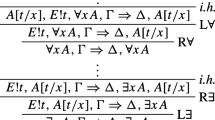Abstract
Second-order quantifier elimination in the context of classical logic emerged as a powerful technique in many applications, including the correspondence theory, relational databases, deductive and knowledge databases, knowledge representation, commonsense reasoning and approximate reasoning. In the current paper we first generalize the result of Nonnengart and Szałas [17] by allowing second-order variables to appear within higher-order contexts. Then we focus on a semantical analysis of conditionals, using the introduced technique and Gabbay’s semantics provided in [10] and substantially using a third-order accessibility relation. The analysis is done via finding correspondences between axioms involving conditionals and properties of the underlying third-order relation.
Similar content being viewed by others
References
Ackermann W. (1935) ‘Untersuchungen über das eliminationsproblem der mathematischen logik’. Mathematische Annalen 110 : 390–413
Burgess J. (1981) ‘Quick completeness proofs for some logics of conditionals’. Notre Dame Journal of Formal Logic 22: 76–84
Conradie, W., V. Goranko, and D. Vakarelov, ‘Algorithmic correspondence and completeness in modal logic. I: the core algorithm SQEMA’, Logical Methods in Computer Science, 2 (2006), 1:5, 1–26.
Doherty P., Kachniarz J., Szałas A.(1999) ‘Meta-queries on deductive databases’. Fundamenta Informaticae 40 (1): 17–30
Doherty, P.,W. Łukaszewicz, A. Skowron, and A. Szałas, Knowledge representation techniques. A rough set approach, vol. 202 of Studies in Fuziness and Soft Computing, Springer-Verlag, 2006.
Doherty P., Łukaszewicz W., Szałas A. (1997) ‘Computing circumscription revisited’. Journal of Automated Reasoning 18 (3): 297–336
Doherty P., łukaszewicz W., Szałas A. (1998) ‘General domain circumscription and its effective reductions’. Fundamenta Informaticae 36 (1): 23–55
Doherty P., Łukaszewicz W., Szałas A. (1999) ‘Declarative PTIME queries for relational databases using quantifier elimination’. Journal of Logic and Computation 9 (5): 739–761
Gabbay, D. M., and H. J. Ohlbach, Quantifier ‘elimination in second-order predicate logic’, South African Computer Journal, 7(1992), 35–43. Also published in B. Nebel, C. Rich, W. R. Swartout, (eds.), Proceedings of the Third International Conference on Principles of Knowledge Representation and Reasoning (KR’92), Morgan Kaufmann, 1992, pp. 425–436.
Gabbay D.M. (1972) ‘A general theory of the conditional in terms of a ternary operator’. Theoria 38: 97–104
Gabbay, D.M., R. Schmidt,and A. Szałas, Second-Order Quantifier Elimination: Mathematical Foundations, Computational Aspects and Applications, Kings College Publications. Studies in Logic Series, 2008.
Herzig, A., ‘SCAN and systems of condtional logic’, Research Report MPI-I-96-2007, Max-Planck-Institut für Informatik, Saarbrücken, Germany, 1996.
Kachniarz, J.,and A. Szałas, ‘On a static approach to verification of integrity constraints in relational databases’, in E. Orłowska, and A. Szałas, (eds.), Relational Methods for Computer Science Applications, Springer Physica-Verlag, 2001, pp. 97– 109.
Lewis, D.K, Counterfactuals, Blackwell, 1973.
Lifschitz, V., ‘Circumscription’, in D. M. Gabbay, C. J. Hogger, and J. A. Robinson, (eds.), Handbook of Artificial Intelligence and Logic Programming, vol. 3, Oxford University Press, 991, pp. 297–352.
Nonnengart, A., H. J. Ohlbach,and A. Szałas, ‘Elimination of predicate quantifiers’, in H. J. Ohlbach, and U. Reyle, (eds.), Logic, Language d Reasoning. Essays in Honor of Dov Gabbay, Part I, Kluwer, 1999, pp. 159–181.
Nonnengart, A., and A. Szałas, ‘A fixpoint approach to second-order quantifier elimination with applications to correspondence theory’, in E. Orłowska, (ed.), Logic at Work: Essays Dedicated to the Memory of Helena Rasiowa, vol. 24 of Studies in Fuzziness and Soft Computing, Springer Physica-Verlag, 1998, pp. 307–328.
Orłowska, E., and A. Szałas, ‘Quantifier elimination in elementary set theory’, in W. MacCaull, M. Winter, and I. Duentsch, (eds.), Relational Methods in Computer Science, no. 3929 in LNCS, Springer, 2006, pp. 237–248.
Simmons H. (1994) ‘The monotonous elimination of predicate variables’. Journal of Logic and Computation 4 : 23–68
Stalnaker, R.C., ‘A theory of conditionals’, in W.L. Harper, R.C. Stalnaker, and G. Pearce, (eds.), Ifs, D. Reidel, 1981, pp. 41–55.
Stalnaker R.C., Thomason R.M. (1970) ‘A semantic analysis of conditional logic’. Theoria 36 (1–3): 23–42
Szałas A. (1993) ‘On the Correspondence between modal and classical logic: An automated approach’. Journal of Logic and Computation 3, 605–620
Szałas A. (1994) ‘On an automated translation of modal proof rules into formulas of the classical logic’. Journal of Applied Non-Classical Logics 4 : 119–127
van Benthem, J., Modal Logic and Classical Logic, Bibliopolis, Naples, 1983.
van Benthem, J., ‘Correspondence theory ’, in D. Gabbay, and F. Guenthner, (eds.), Handbook of Philosophical Logic, vol. 2, D. Reidel Pub. Co., 1984, pp. 167–247.
Author information
Authors and Affiliations
Corresponding author
Rights and permissions
About this article
Cite this article
Gabbay, D.M., Szałas, A. Second-Order Quantifier Elimination in Higher-Order Contexts with Applications to the Semantical Analysis of Conditionals. Stud Logica 87, 37–50 (2007). https://doi.org/10.1007/s11225-007-9075-4
Received:
Published:
Issue Date:
DOI: https://doi.org/10.1007/s11225-007-9075-4




